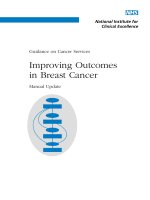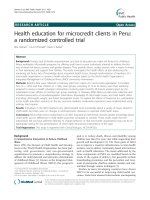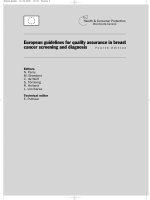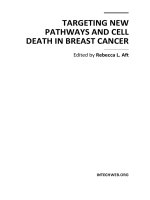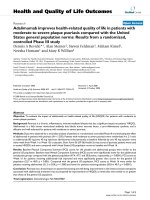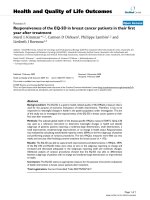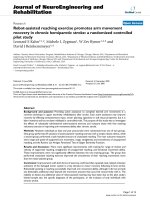Factors influencing participation in a randomized controlled resistance exercise intervention study in breast cancer patients during radiotherapy
Bạn đang xem bản rút gọn của tài liệu. Xem và tải ngay bản đầy đủ của tài liệu tại đây (440.82 KB, 9 trang )
Gollhofer et al. BMC Cancer (2015) 15:186
DOI 10.1186/s12885-015-1213-1
RESEARCH ARTICLE
Open Access
Factors influencing participation in a randomized
controlled resistance exercise intervention study
in breast cancer patients during radiotherapy
Sandra M Gollhofer1, Joachim Wiskemann1,3,6*, Martina E Schmidt1,2, Oliver Klassen1, Cornelia M Ulrich5,
Jan Oelmann4, Holger Hof4, Karin Potthoff3,4† and Karen Steindorf1,2†
Abstract
Background: Over the past years knowledge about benefits of physical activity after cancer is evolving from
randomized exercise intervention trials. However, it has been argued that results may be biased by selective
participation. Therefore, we investigated factors influencing participation in a randomized exercise intervention trial
for breast cancer patients.
Methods: Non-metastatic breast cancer patients were systematically screened for a randomized exercise intervention
trial on cancer-related fatigue. Participants and nonparticipants were compared concerning sociodemographic
characteristics (age, marital status, living status, travel time to the training facility), clinical data (body-mass-index,
tumor stage, tumor size and lymph node status, comorbidities, chemotherapy), fatigue, and physical activity.
Reasons for participation or declination were recorded.
Results: 117 patients (52 participants, 65 nonparticipants) were evaluable for analysis. Multiple regression analyses
revealed significantly higher odds to decline participation among patients with longer travel time (p = 0.0012),
living alone (p = 0.039), with more comorbidities (0.031), previous chemotherapy (p = 0.0066), of age ≥ 70 years
(p = 0.025), or being free of fatigue (p = 0.0007). No associations were found with BMI or physical activity. By far
the most frequently reported reason for declination of participation was too long commuting time to the
training facility.
Conclusions: Willingness of breast cancer patients to participate in a randomized exercise intervention study
differed by sociodemographic factors and health status. Neither current physical activity level nor BMI appeared
to be selective for participation. Reduction of personal inconveniences and time effort, e.g. by decentralized
training facilities or flexible training schedules, seem most promising for enhancing participation in exercise
intervention trials.
Trial registration: Registered at ClinicalTrials.gov: NCT01468766 (October 2011).
Keywords: Clinical trial, Physical activity, Oncology, Randomized controlled trial, Recruitment
* Correspondence:
†
Equal contributors
1
Unit of Physical Activity and Cancer, Department of Preventive Oncology,
German Cancer Research Center and National Center for Tumor Diseases, Im
Neuenheimer Feld 460, 69120 Heidelberg, Germany
3
Department of Medical Oncology, National Center for Tumor Diseases, Im
Neuenheimer Feld 460, 69120 Heidelberg, Germany
Full list of author information is available at the end of the article
© 2015 Gollhofer et al.; licensee BioMed Central. This is an Open Access article distributed under the terms of the Creative
Commons Attribution License ( which permits unrestricted use, distribution, and
reproduction in any medium, provided the original work is properly credited. The Creative Commons Public Domain
Dedication waiver ( applies to the data made available in this article,
unless otherwise stated.
Gollhofer et al. BMC Cancer (2015) 15:186
Page 2 of 9
Background
In recent years an increasing number of studies have
been published, evaluating the role of physical activity
during or after cancer treatment. It has been shown that
structured exercise training can reduce adverse effects in
cancer patients like cancer-related fatigue (CRF) [1-3],
improve quality of life [4] and positively impact cardiorespiratory fitness [5]. Most of the findings are based on
clinical studies with small numbers of subjects or patients, and there is an ongoing debate whether those patients willing to be randomized to a demanding exercise
program might be highly selective [6,7]. Clinical trials
are essential for research and randomized controlled
studies are considered the gold standard to evaluate new
therapies and determine efficacy or effectiveness of interventions [8]. However, only 3-5% of all cancer patients in Great Britain and the US are included in
randomized controlled studies [9]. These low rates result
from strict study protocols together with patient- and
physician related factors, e.g. time constraints or influence on the relationship between physician and patient.
Moreover, it has been shown that the process of recruitment itself is very selective and often threatens the
generalizability [10]. Data from clinical cancer trials
(mostly drug studies) suggest that age [11,12], tumor
stage [13,14], lymph node involvement [12], comorbidities [12], and travel distance [15,16] play an important
role in the acceptance or non-acceptance in study participation. De Jong et al. [17] determined differences between participants and nonparticipants of an exercise
trial for patients with rheumatoid arthritis. They concluded that nonparticipants were older, mainly males, suffered for a longer duration from their disease and had a
lower level of education. To our knowledge, the determinants of participation of cancer patients in exercise intervention trials have not yet been systematically investigated
in this extent. It is important to explore these determinants to improve participation rates in further trials.
Therefore aim of the present study was to investigate
factors that explain participation and nonparticipation in
an exercise intervention trial for breast cancer patients
undergoing adjuvant radiotherapy. This study focuses on
demographic, personal and clinical factors associated
with participation, as well as patient motivation.
metastatic breast cancer patients undergoing adjuvant
radiotherapy. The BEST-study compared a 12-week resistance intervention program during and after radiotherapy
with relaxation training in regard to cancer-related fatigue
perception [18,19]. The BEST-Participation-study was an
observational study embedded in the BEST-study, collecting information on factors potentially influencing willingness to participate in a randomized exercise-intervention
trial. The aims of the present analysis were (1) to determine
clinical and sociodemographic characteristics of participants and nonparticipants, and (2) to identify reasons for
participation or declination. Patients, who signed informed
consent for the BEST trial automatically took part in the
BEST-Participation-study and are referred to as participants
throughout this manuscript. Patients, who refused participation in the BEST-study but agreed to fill out the short
questionnaire for the BEST-Participation-study, are referred
to as nonparticipants.
Protocols of the BEST- and of the BEST-Participationstudy were approved by the Ethic Committee of the
University of Heidelberg and have been performed in
accordance with the ethical standards of the Declaration of Helsinki. The BEST-study is registered at ClinicalTrials.gov (NCT01468766).
Methods
Study recruitment
Study design
Eligible patients were briefly informed about the exercise
trial at their first consultation for radiotherapy at the
outpatient clinic of the Department of Radiooncology of
the NCT. Interested patients were handed out an information sheet. They were called a few days later to get
more comprehensive information.
Upon informed consent women were included in the
BEST-study as well as in the BEST-Participation-study. As
The present BEST-Participation-study was carried out
from July 2011 to December 2011 during the patient
screening for the BEST-study. The BEST-study (in German:
Bewegung und Entspannung für Brustkrebspatientinnen
unter Strahlentherapie, translation: exercise and relaxation
for breast cancer patients during radiotherapy) is a prospective, randomized, controlled intervention trial for non-
Study population
All participants were treated at the National Center for
Tumor Diseases Heidelberg (NCT) in cooperation with
the Department of Radiooncology of the University Medical Centre in Heidelberg. Inclusion criteria were: female
breast cancer patients with UICC stage I-III, indication for
adjuvant radiotherapy, age ≥ 18 years, BMI ≥ 18 kg/m2,
written informed consent, ability to follow instructions.
Exclusion criteria were: acute infection, problems with
walking or standing, severe neurological dysfunction, severe cardiovascular disease, severe pulmonary insufficiency, severe renal insufficiency, other malignancies
(except carcinoma in situ of skin or cervix), abuse of alcohol or drugs, regular participation in resistance or endurance training. Breast cancer patients were recruited by a
physician who was responsible for the assessment of inclusion and exclusion criteria. Both nonparticipants and
participants had to fulfill these BEST-inclusion criteria.
Gollhofer et al. BMC Cancer (2015) 15:186
participants they had to fill out relevant questionnaires
(see below) at their baseline visit for the study entry.
Patients refusing participation were asked whether they
would be willing to provide some reasons for their declination and to complete a brief questionnaire either immediately in the outpatient clinic or at home, returned by
mail. Written informed consent was obtained from both,
BEST participants and nonparticipants. For the recruitment flow see Figure 1.
Data collection
Clinical data, including tumor size, lymph node status,
tumor stage, comorbidities, chemotherapy (yes/no), age,
BMI, were collected from the clinical information system. Additional information, such as sociodemographic
data, fatigue, physical activity and motivational aspects
for exercise, was assessed by self-administered questionnaires. Patients were asked to specify marital status (married/living with partner, separated, divorced, widowed,
single, not specified), living status (alone, with others) and
travel distance (up to 30 min, between 30 min and 1 h,
more than 1 h) to the training center. For a baseline assessment of physical activity reflecting the last week prior
to inclusion we used the short version of the Freiburg
questionnaire of physical activity (FFKA) [20], a standardized and validated instrument. FFKA focuses on everyday
activity with low to medium exertion in addition to exercise activities. With 8 questions basal, recreational and
sportive activities are assessed. Cancer-related fatigue, the
primary endpoint of the BEST-study, was measured by the
multidimensional, 20-item Fatigue Assessment Questionnaire (FAQ) [21]. FAQ is a standardized and validated
questionnaire for self-assessment of the physical, cognitive
and affective dimensions of fatigue. In addition, using a
visual analogue scale (0 = not tired at all, 10 = totally
exhausted), patients were asked to rate the intensity of
current fatigue. Besides the continuous fatigue scores
(total physical, cognitive and affective fatigue) we also
Figure 1 Recruitment flow.
Page 3 of 9
investigated a dichotomous variable using as cutpoint the
mean fatigue score of women age ≥ 60 years from the general German population (FAQ point value for women
aged 14–39 years: 11,2; aged 40–59 years: 12,1; aged ≥
60 years) [22].To assess the motivation of patients to
participate in the BEST-study they could choose among
7 answers, in addition to provide their own free text.
Nonparticipants had the choice between 15 answers
and free text to explain why they decided against study
participation. Multiple answers were allowed.
If the questionnaires were not returned, patients were
reminded at least three times by phone. All questionnaires
and clinical information had to be completed prior to the
first radiotherapy.
Statistical analysis
Characteristics of participants and nonparticipants were
compared using Student’s t-test (metric data), Mann–
Whitney-U-test (ordinal data), or Chi2-test (categorical
data). To assess the associations between the characteristics and nonparticipation, we performed multiple logistic regression analyses assessing following covariates
simultaneously in the model: age group, number of comorbidities, marital status, living status, travel distance,
BMI, previous chemotherapy, and fatigue. Due to high
collinearity tumor characteristics were investigated in
separate models without chemotherapy. The different
physical activity variables were also included in the
models, but none showed a significant association with
nonparticipation. Additional sensitivity analyses were
performed using smaller sets of covariates to check for
overfitting or spurious effects by related variables, but
there were no substantial changes in the results. Reasons
for participation or declination were analyzed descriptively. P-values below 0.05 were considered as statistically significant. All analyses were performed using
PASW Statistics 19.0 or SAS 9.2 [SAS Institute Inc.,
Cary, USA].
Gollhofer et al. BMC Cancer (2015) 15:186
Results
From July to December 2011 a total of 398 patients with
non-metastatic breast cancer were irradiated at the study
clinic. In this period 52 participants and 69 nonparticipants
were recruited (Figure 1). Due to missing data from 4 nonparticipants the sample was restricted to 65 evaluable nonparticipants. The remaining 277 patients were either not
eligible, received no information from the recruiting physicians or were not interested in any study participation.
Thus, information for this BEST-Participation-study was
available for 30.4% of all breast cancer patients with adjuvant radiotherapy during the study period.
Characteristics of participants and non-participants
Sociodemographic characteristics are presented in
Table 1. The mean age did not differ statistically significantly between participants and nonparticipants (p =
0.64). However, participants were more likely to be middle aged (age 40–70 years) whereas nonparticipants were
more likely to be younger or older (<40 years, ≥ 70 years)
(p = 0.02). Significant differences were also noted for living status (p = 0.009) and travel distance (p = 0.02). Here,
the nonparticipants more commonly reported living
alone and had to spend more time to travel from their
home to the treatment center. There were no significant
differences with respect to marital status (p = 0.18).
Tumor size (p = 0.047), nodal status (p = 0.036) and
tumor stage (p = 0.043) were indicative for a locally more
advanced disease among nonparticipants. The number
of comorbidities tended to be higher in nonparticipants
(p = 0.066). Prior treatment with chemotherapy was somewhat more frequently reported by nonparticipants (p =
0.09). No difference between both groups was observed
for BMI (p = 0.14).
Participants and nonparticipants had comparable
current physical activity levels (p > .99) (see Table 2).
Only 34.6% of the participants and 33.8% of the nonparticipants were classified as “sufficiently active” according
to the criteria of Frey and Berg [23] (total score in the
FFKA of 30 or a score of 14 in sportive activities) prior
to starting radiotherapy. Compared to a healthy reference group [20] our entire study population was comparably active in day-to-day and recreational activities,
but less so with respect to exercise activities.
Neither total fatigue levels (p = 0.25) nor levels for the
subcategories physical, cognitive, and affective fatigue or
sleep problems differed significantly between the groups
(see Table 3). There was also no significant difference
between participants and nonparticipants with regard to
their fatigue levels the year before diagnosis, at the days
after surgery, or during chemotherapy (if applicable).
However, among nonparticipants significantly (p = 0.01)
more women were currently free of fatigue (i.e. with
Page 4 of 9
levels below the mean fatigue level of the general reference population) than among participants.
Multiple logistic regression analyses (see Table 4) showed
significantly higher odds for nonparticipation among patients with higher age, higher number of comorbidities,
those living alone, having longer travel distances, having received a chemotherapy, or those not feeling fatigued. Divorced or separated women had lower odds to refuse
participation. BMI and physical activity were not associated
with participation.
Due to high collinearity, the variables tumor stage, tumor
size, and chemotherapy were not included jointly in a
model. Similar results were observed in the models with either tumor stage or tumor size instead of chemotherapy,
with OR = 3.3 (1.2 – 9.3) for higher stage vs. lower stage,
and OR = 4.6 (1.4 – 15.1) for tumor sizes T2/3 vs. T1/Tis
(data not shown).
Reasons for participation or non-participation
When asked for their reasons for acceptance or declination of the study the five most frequently stated motivational aspects of BEST participants were: “I hope to
reduce fatigue and improve quality of life” (65.4%), “I want
to contribute to scientific progress” (65.4%), “I hope for
positive effects on my cancer prognosis” (59.6%), “I want
to cope with cancer” (59.6%), “I hope for better fitness and
health” (57.7%) (see Table 5). Nonparticipants most often
named “Journey too far/difficulties to reach training center” (70.8%) as reason for their declination. “Time conflicts” (23.1%) and “Twice a week training is too much”
(13.8%) were followed by “Health problems” and “I do not
want to participate in relaxation” (both 12.3%) (see
Table 6).
Discussion
The present study showed that willingness of breast cancer
patients to participate in a randomized exercise intervention study was significantly influenced by age distribution,
comorbidities, living status, travel time to the training center, cancer characteristics or treatment, and fatigue. No associations were observed with BMI and extent of current
physical activity.
Patient’s well-being often is negatively influenced by
cancer itself as well as by common cancer therapies. Intervention studies have revealed the importance of physical activity as an effective method in supportive therapy
[1,2,4,5].
In literature, generalizability of results from clinical trials to the overall patient population has been questioned
[12,14,24]. Discrepancies between willingness in general
expressed by healthy persons to participate in a clinical
cancer trial versus actual participation rates in patient
populations have been addressed in the study from
Comis et al. 2003: In a survey healthy Americans were
Gollhofer et al. BMC Cancer (2015) 15:186
Page 5 of 9
Table 1 Sociodemographic and clinical characteristics of participants and nonparticipants
Mean age (SD)
Total (n = 117)
Participants (n = 52)
Nonparticipants (n = 65)
57.0 (11.3)
56.5 (9.3)
57.5 (12.7)
Age groups
0.64
0.02
<40 years
7 (6%)
1 (1.9%)
6 (9.2%)
40-49 years
24 (20.5%)
14 (26.9% )
10 (15.4%)
50-59 years
37 (31.6%)
17 (32.7%)
20 (30.8%)
60-69 years
31 (26.5%)
17 (32.7%)
14 (21.5%)
≥70 years
18 (15.4%)
3 (5.8%)
15 (23.1%)
Married/living with partner
78 (66.7%)
38 (73.1%)
40 (61.5%)
Separated
3 (2.6%)
2 (3.8%)
1 (1.5%)
Divorced
11 (9.4%)
6 (11.5%)
5 (7.7%)
Widowed
18 (15.4%)
5 (9.6%)
13 (20%)
Single
7 (6.0%)
1 (1.9%)
6 (9.2%)
Alone
32 (27.4%)
8 (15.4% )
24 (36.9%)
With others
85 (72.6%)
44 (84.6%)
41 (63.1%)
Up to 30 minutes
30 (25.6% )
18 (34.6%)
12 (18,5%)
Between 30 minutes and 1 h
67 (57.3%)
30 (57.7%)
37 (56.9%)
More than 1 h
20 (17.1%)
4 (7.7%)
16 (24.6%)
26.3 (4.5)
25.7 (4.7)
26.9 (4.4)
Tis
16 (13.7%)
8 (15.4%)
8 (12.3%)
T1
66 (56.4%)
34 (65.4%)
32 (49.2%)
T2
30 (25.6%)
9 (17.3%)
21 (32.3%)
T3
5 (4.3%)
1 (1.9%)
4 (6.2%)
Positive
34 (29.1%)
10 (19.2%)
24 (36.9%)
Negative
83 (70.9%)
42 (80.8%)
41 (63.1%)
0
15 (12.8%)
8 (15.4% )
7 (10.8%)
1
55 (47.0%)
29 (55.8%)
26 (40.0%)
2
35 (29.9%)
11 (21.2%)
24 (36.9%)
3
12 (10.3%)
4 (7.7%)
8 (12.3%)
0
48 (41.0%)
25 (48.1%)
23 (35.4%)
1
43 (36.8%)
20 (38.5%)
23 (35.4%)
Marital status
0.18
Living status
0.01
Travel distance
Mean BMI [kg/m2] (SD)
p-Value
0.02
Tumor size
0.14
0.047
Nodal status
0.04
Tumor stage (UICC)
0.04
Number of comorbidities
0.07
2
14 (12.0%)
3 (5.8%)
11 (16.9%)
≥3
12 (10.3%)
4 (7.7%)
8 (12.3%)
yes
46 (39.3%)
16 (30.8%)
30 (46.2%)
no
71 (60.7%)
36 (69.2%)
35 (53.8%)
any
83 (70.9%)
43 (82.7%)
40 (61.5%)
none
34 (29.1%)
9 (17.3%)
25 (38.5%)
Chemotherapy
0.09
Fatigue
SD: Standard Deviation.
0.01
Gollhofer et al. BMC Cancer (2015) 15:186
Page 6 of 9
Table 2 Physical activity levels of participants and nonparticipants (BEST-study) according to the short version of the
FFKA
Total (n = 117)
Participants (n = 52)
Nonparticipants (n = 65)
p-Value
Total activity score* (SD)
27.9 (25.8)
28.2 (26.4)
27.6 (25.5)
>0.99
Basal activities* (SD)
10.6 (11.4)
10.6 (11.3)
10.6 (11.6)
0.79
Recreational activities* (SD)
12.5 (12.4)
13.0 (12.1)
12.1 (12.8)
0.48
Sportive activities* (SD)
4.8 (11.9)
4.6 (13.2)
4.9 (10.8)
0.89
*MET x hours/week.
SD: Standard Deviation, MET: metabolic equivalent of task.
asked about their willingness to participate in a clinical
cancer trial if they were faced with cancer diagnosis. 31%
indicated to be “very willing”, 51% “somewhat willing”,
9% “not very willing” and 6% “not willing at all” [25].
This is in clear contrast to the finding that only 3 to 5%
of all cancer patients in Great Britain and the US participate in clinical trials [9]. Reasons may be that no appropriate study was open, patients were not informed about
ongoing studies or were ineligible, or patients were not
willing to participate. In the BEST-study 13.1% of the
target population could be enrolled during the recruitment period (from July to December 2011). In consequence it is assumed that participation in intervention
studies is highly selective.
In the present study, travel distance was a major factor
reducing study participation: Participation in the intervention trial required the acceptance to travel twice a
week to the treatment center and to spend extra time for
the training. The present study shows that patients who
needed significantly less time to reach the training centre
were more likely to agree. Furthermore, 70.8% of the nonparticipants named “journey too far/difficulties to reach
training centre” as an important reason for refusing to
participate. Long travel distances and limited transportation capabilities are held responsible for less utilization of
cancer treatment [26]. In line, studies from gynecological
cancer types reported that travel distance and study participation are reciprocally related to each other [15].
Participants of the BEST-study represented the age
group between 40 to 69 years very well. However, patients aged younger than 40 years or older than 69 years
only accounted for 7.7% of the trial participants whereas
32.2% of the nonparticipants were classified in these
groups. Higher age was even significantly associated with
nonparticipation when adjusting for other factors such
as comorbidities. Our results strengthen previous studies
observing that especially older patients are underrepresented in clinical trials, although they comprise about
one third of newly diagnosed breast cancer patients
[12,27,28]. A detailed explanation for the selected representation of younger patients cannot be determined due
to the small size of this age group.
In the BEST-Participation-study among nonparticipants a larger proportion reported living alone. Participants tended to be more often married, while widowed
or single women were more frequent among nonparticipants, but differences were not statistically significant.
Our data suggest that social and perhaps logistical support is an important component when considering participation in a rather time-consuming clinical exercise
trial. These data are in line with Elting et al. [12] who
compared social factors of participants and nonparticipants with different cancer types. However, two other
studies could not find such associations [17,29].
Comparable to Elting et al. who observed higher percentages of comorbidities in nonparticipants [12], the
present study revealed a statistical association between
more comorbidities and nonparticipation when adjusting
for other characteristics. Participants had smaller tumor
sizes, lower tumor stages and less frequently positive
lymph nodes than nonparticipants. Potentially, physical
activity intervention trials are selective for patients with
less advanced and rather local disease.
Importantly, nonparticipants and participants did not
differ in their physical activity level and both groups
showed a predominantly sedentary lifestyle. Thus, the
present study suggests that exercise intervention studies
are not selectively addressing more active patients. Likewise
Table 3 Fatigue levels of participants and nonparticipants (BEST-study) according to FAQ
Total (n = 117)
Participants (n = 52)
Nonparticipants (n = 65)
p-Value
Total fatigue (SD)
22.1 (13.8)
23.5 (11.1)
20.9 (15.7)
0.25
Physical fatigue (SD)
12.4 (8.9)
12.8 (7.7)
12.1 (9.8)
0.43
Cognitive fatigue (SD)
2.9 (2.6)
3.2 (2.2)
2.7 (2.8)
0.14
Affective fatigue (SD)
5.4 (4.0)
6.1 (3.7)
4.9 (4.2)
0.06
Sleep problems
1.4 (1.1)
1.5 (1.0)
1.3 (1.1)
0.24
SD: Standard Deviation.
Gollhofer et al. BMC Cancer (2015) 15:186
Page 7 of 9
Table 4 Multiple logistic regression model assessing the
odds for nonparticipation
Table 5 Motivations for study participation reported by
participants of the BEST-study
Covariates
p
Participant’s motivations (n = 52)
0.025
I want to contribute to scientific progress, that future patients
benefit thereof
OR (95% CI)
Age groups
<40 years
6.5 (0.5 – 86.4))
40-49 years
Ref.
65.4%
I hope to reduce fatigue and improve quality of life
65.4%
59.6%
50-59 years
3.7 (0.9 – 15.8)
I hope for positive effects on cancer prognosis
60-69 years
1.0 (0.2 – 5.7)
I want to cope with cancer
59.6%
16.1 (1.7 – 150.4)
I hope for better fitness and health
57.7%
Social contact to other persons concerned
38.5%
Recommendation of the physician
28.8%
Other reasons
7.7%
≥70 years
Number of comorbidities
0.031
0
Ref.
1
2.8 (0.8 – 10.0)
≥2
10.6 (1.8 – 62.1)
Marital status
0.047
Married/ living with partner
Ref.
Separated/divorced
0.1 (0.02 – 0.9)
Widowed
0.2 (0.03 – 1.3)
Single
14.3 (0.4 – 581.8)
Living status
0.039
With others
Ref.
Alone
6.5 (1.1 – 38.3)
Travel distance
Up to 30 minutes
0.0012
Ref.
Between 30 minutes and 1 h
12.3 (2.7 – 56.7)
More than 1 h
19.4 (3.4 – 110.8)
Body mass index
diagnosis. In contrast to these results Truong et al. [31]
showed that altruism is not the primary reason for accepting participation. Catt et al. [32] also discussed personal
benefits to be responsible for acceptance or non-acceptance
of trial inclusion. In the Best-Participation-study we observed both of these motivations. “I hope to reduce fatigue
and improve quality of life” and “I want to contribute to scientific progress, that future patients benefit thereof” were
the two most frequent statements. Thus, the feeling to influence cancer prognosis and to positively impact the own
health status seems both to be important to patients.
Declination of study participation in the BEST-study
was largely attributable to the distance to get to the
training centre or to difficulties related to commuting.
Previous studies also showed that distance and limited
0.33
Normal
Ref.
Overweight
2.2 (0.7 – 7.0)
Table 6 Reasons for declination of study participation
given by nonparticipants of the BEST-study
Adipose
2.3 (0.5 – 10.1)
Nonparticipant’s reasons (n = 65)
Journey too far/difficulties to reach training centre
70.8%
Ref.
Time conflicts
23.1%
5.3 (1.6 – 17.8)
Twice a week training is too much
13.8%
Health problems
12.3%
12.3%
Chemotherapy
No
Yes
0.0066
Fatigue
0.0007
Any
Ref.
I do not want to participate in relaxation
None
12.7 (2.9 – 54.9)
Dislike of randomization
10.8%
Additional time for questionnaires and measurements
is too much
9.2%
Pain
9.2%
Resistance training too exhausting
7.7%
OR: odds ratio; CI: confidence interval.
Bold numbers indicate statistically significant results at level 0.05.
the BEST-Participation-study found no influence of BMI
on participation in an exercise trial. As the BEST-study focuses on interventions against fatigue, it is not surprising
that patients who did not feel fatigued at all were more
likely to refuse study participation.
In the literature two main theories are discussed to explain motivation of participants to participate in clinical
trials: Altruistic motives as well as self-interested arguments. Jenkins and Fallowfield [30] found that a major
argument for participation in clinical trials is the desire
to help future patients who are confronted with cancer
Too tired or not motivated enough
6.2%
I can’t be bothered
3.1%
Doubts about meaningfulness of the study
1.5%
Doubts about benefit of the training
1.5%
Investigation too burdensome/ inconvenient
1.5%
1 h training/session is too much
1.5%
Prefer not to give reasons
1.5%
Other reasons
15.4%
Gollhofer et al. BMC Cancer (2015) 15:186
transportation possibilities can be barriers for study participation [33,34]. In a review Ross et al. [35] concluded
that long travel distances associated with higher costs led
to a declination of study participation and higher dropout
rates. “Date difficulties”, “Twice a week training is too
much” and “Additional time for questionnaires and measurements is too much” can be summarized as additional
logistical constraints that may be important in line with
findings from other studies [34,36].
Our study had several strengths: By including only
patients who were classified to be eligible through the
BEST-study protocol and were offered participation from
physicians we were able to investigate patient-related factors in relation to participation and nonparticipation. In
contrast, most of the previous studies investigating these
differences used retrospective designs where recruitment
procedures and criteria were not fully comparable between participants and nonparticipants. Furthermore we
collected additional information like fatigue status or
physical activity level which are important variables in the
emerging field of exercise interventions among cancer patients. A limitation of our BEST-Participation-study is,
that as most of the clinical studies, we also cannot report
on the exact percentage of contacted patients with respect
to the entire target population. Due to organizational difficulties in the recruitment process, such as short-term alterations of the medical staff or time constraints of the
physicians, not all patients were informed about the
BEST-study, and among patients not willing to participate in BEST, not all were asked to complete the questionnaires of the BEST-Participation-study. Beyond that
a certain proportion of the target population decided
against any study participation, so that only 30.4% of all
patients with breast cancer stage I-III responded to the
BEST-Participation-study, either with participation or
non-participation in the BEST-study. Further research is
necessary to verify these aspects in detail.
Conclusions
Our study suggest that breast cancer patients are less
willing or able to participate in a randomized resistance
exercise trial if they live alone, have a long travel distance, a worse cancer prognosis, had a recent chemotherapy, are affected by fatigue, are above age 70 or have
more comorbidities. However, there seemed to be no selection by current physical activity level or BMI. By far
the most frequently reported reason for declination of
participation was too long commuting time to the training facility. Our results might help to improve participation by adapting recruitment procedures in future
exercise intervention studies appropriately.
Competing interests
The authors declare that they have no competing interests.
Page 8 of 9
Authors’ contributions
SG performed the data collection and study coordination and drafted the
manuscript. JW developed the research question and supervised the data
collection. MS participated in the design of the study and performed the
statistical analysis. OK was responsible for the study organization and
coordination. CU helped to draft the manuscript. JO, HH and KP recruited
the patients and performed the medical check-up with regard to the study
inclusion criteria. KS conceived and supervised the whole study process and
helped to draft the manuscript. All authors read and approved the final
manuscript.
Acknowledgements and Funding
The BEST trial is funded by the Interdisciplinary Research Funding Program
(intramural) of the National Center for Tumor Diseases (NCT), Heidelberg.
The authors thank Werner Diehl for Data Management.
Author details
1
Unit of Physical Activity and Cancer, Department of Preventive Oncology,
German Cancer Research Center and National Center for Tumor Diseases, Im
Neuenheimer Feld 460, 69120 Heidelberg, Germany. 2Unit of Environmental
Epidemiology, German Cancer Research Center, Im Neuenheimer Feld 280,
69120 Heidelberg, Germany. 3Department of Medical Oncology, National
Center for Tumor Diseases, Im Neuenheimer Feld 460, 69120 Heidelberg,
Germany. 4Department of Radiation Oncology, University of Heidelberg
Medical Center, Im Neuenheimer Feld 400, 69120 Heidelberg, Germany.
5
Department of Preventive Oncology, National Center for Tumor Diseases, Im
Neuenheimer Feld 460, 69120 Heidelberg, Germany. 6National Center for
Tumor Diseases (NCT), Divisions of Medical Oncology and Preventive
Oncology, Im Neuenheimer Feld 460, 69120 Heidelberg, Germany.
Received: 6 August 2013 Accepted: 18 March 2015
References
1. Velthuis MJ, Agasi-Idenburg SC, Aufdemkampe G, Wittink HM. The effect
of physical exercise on cancer-related fatigue during cancer treatment:
a meta-analysis of randomised controlled trials. Clin Oncol (R Coll Radiol).
2010;22(3):208–21.
2. Berger AM, Gerber LH, Mayer DK. Cancer-related fatigue: implications for
breast cancer survivors. Cancer. 2012;118(8 Suppl):2261–9.
3. Jones LW, Alfano CM. Exercise-oncology research: Past, present, and future.
Acta Oncol. 2013;52(2):195–215.
4. Cramp F, James A, Lambert J. The effects of resistance training on quality of
life in cancer: a systematic literature review and meta-analysis. Support Care
Cancer. 2010;18(11):1367–76.
5. Lakoski SG, Eves ND, Douglas PS, Jones LW. Exercise rehabilitation in
patients with cancer. Nat Rev Clin Oncol. 2012;9(5):288–96.
6. van Dijk-Lokkart EM, Braam KI, Huisman J, Kaspers GJ, Takken T, Veening MA,
et al. Factors influencing childhood cancer patients to participate in a
combined physical and psychosocial intervention program: Quality of
Life in Motion. Psychooncology. 2014; doi: 10.1002/pon.3677. [Epub
ahead of print]
7. Adams RN, Mosher CE, Blair CK, Snyder DC, Sloane R, Demark-Wahnefried
W. Cancer survivors' uptake and adherence in diet and exercise intervention
trials: An integrative data analysis. Cancer. 2015;121(1):77–83.
8. Dwan K, Gamble C, Williamson PR, Altman DG. Reporting of clinical trials:
a review of research funders' guidelines. Trials. 2008;9:66.
9. Harrison JD, Solomon MJ, Young JM, Meagher A, Hruby G, Salkeld G, et al.
Surgical and oncology trials for rectal cancer: who will participate? Surgery.
2007;142(1):94–101.
10. Gross CP, Mallory R, Heiat A, Krumholz HM. Reporting the recruitment
process in clinical trials: who are these patients and how did they get
there? Ann Intern Med. 2002;137(1):10–6.
11. Kemeny MM, Peterson BL, Kornblith AB, Muss HB, Wheeler J, Levine E, et al.
Barriers to clinical trial participation by older women with breast cancer.
J Clin Oncol. 2003;21(12):2268–75.
12. Elting LS, Cooksley C, Bekele BN, Frumovitz M, Avritscher EB, Sun C, et al.
Generalizability of cancer clinical trial results: prognostic differences
between participants and nonparticipants. Cancer. 2006;106(11):2452–8.
Gollhofer et al. BMC Cancer (2015) 15:186
13. Simon MS, Du W, Flaherty L, Philip PA, Lorusso P, Miree C, et al. Factors
associated with breast cancer clinical trials participation and enrollment at
a large academic medical center. J Clin Oncol. 2004;22(11):2046–52.
14. Al-Refaie WB, Vickers SM, Zhong W, Parsons H, Rothenberger D, Habermann
EB. Cancer trials versus the real world in the United States. Ann Surg.
2011;254(3):438–42. discussion 442–433.
15. Legge F, Eaton D, Molife R, Ferrandina G, Judson I, de Bono J, et al.
Participation of patients with gynecological cancer in phase I clinical
trials: two years experience in a major cancer center. Gynecol Oncol.
2007;104(3):551–6.
16. Courneya KS, Segal RJ, Mackey JR, Gelmon K, Reid RD, Friedenreich CM,
et al. Effects of aerobic and resistance exercise in breast cancer patients
receiving adjuvant chemotherapy: a multicenter randomized controlled trial.
J Clin Oncol. 2007;25(28):4396–404.
17. de Jong Z, Munneke M, Jansen LM, Ronday K, van Schaardenburg DJ, Brand
R, et al. Differences between participants and nonparticipants in an exercise
trial for adults with rheumatoid arthritis. Arthritis Rheum. 2004;51(4):593–600.
18. Potthoff K, Schmidt ME, Wiskemann J, Hof H, Klassen O, Habermann N, et al.
Randomized controlled trial to evaluate the effects of progressive resistance
training compared to progressive muscle relaxation in breast cancer
patients undergoing adjuvant radiotherapy: the BEST study. BMC Cancer.
2013;13:162.
19. Steindorf K, Schmidt ME, Klassen O, Ulrich CM, Oelmann J, Habermann N,
et al. Randomized, controlled trial of resistance training in breast cancer
patients receiving adjuvant radiotherapy: results on cancer-related fatigue
and quality of life. Ann Oncol. 2014;25(11):2237–43.
20. Frey I, Berg A, Grathwohl D, Keul J. Freiburg Questionnaire of physical
activity–development, evaluation and application. Soz Praventivmed.
1999;44(2):55–64.
21. Glaus A, Muller S. Measuring fatigue of cancer patients in the Germanspeaking region: development of the Fatigue Assessment Questionnaire.
Pflege. 2001;14(3):161–70.
22. Beutel ME, Hinz A, Albani C, Brahler E. Fatigue assessment questionnaire:
standardization of a cancer-specific instrument based on the general
population. Oncology. 2006;70(5):351–7.
23. Frey I, Berg A. Körperliche Aktivität in Prävention und Therapie
Evidenzbasierter Leitfaden für Klinik und Praxis. Hand Marseille Verlag
GmbH, München: Samitz G., Mensink G.B.M; 2002.
24. Cottin V, Arpin D, Lasset C, Cordier JF, Brune J, Chauvin F, et al. Small-cell
lung cancer: patients included in clinical trials are not representative of the
patient population as a whole. Ann Oncol. 1999;10(7):809–15.
25. Comis RL, Miller JD, Aldige CR, Krebs L, Stoval E. Public attitudes toward
participation in cancer clinical trials. J Clin Oncol. 2003;21(5):830–5.
26. Guidry JJ, Aday LA, Zhang D, Winn RJ. Transportation as a barrier to cancer
treatment. Cancer Pract. 1997;5(6):361–6.
27. Murthy VH, Krumholz HM, Gross CP. Participation in cancer clinical trials:
race-, sex-, and age-based disparities. JAMA. 2004;291(22):2720–6.
28. Hurria A. Clinical trials in older adults with cancer: past and future. Oncology
(Williston Park). 2007;21(3):351–8. discussion 363–354, 367.
29. Mancini J, Geneve J, Dalenc F, Genre D, Monnier A, Kerbrat P, et al.
Decision-making and breast cancer clinical trials: how experience challenges
attitudes. Contemp Clin Trials. 2007;28(6):684–94.
30. Jenkins V, Fallowfield L. Reasons for accepting or declining to participate in
randomized clinical trials for cancer therapy. Br J Cancer. 2000;82(11):1783–8.
31. Truong TH, Weeks JC, Cook EF, Joffe S. Altruism among participants in
cancer clinical trials. Clin Trials. 2011;8(5):616–23.
32. Catt S, Langridge C, Fallowfield L, Talbot DC, Jenkins V. Reasons given by
patients for participating, or not, in Phase 1 cancer trials. Eur J Cancer.
2011;47(10):1490–7.
33. Baggstrom MQ, Waqar SN, Sezhiyan AK, Gilstrap E, Gao F, Morgensztern D,
et al. Barriers to enrollment in non-small cell lung cancer therapeutic clinical
trials. J Thorac Oncol. 2011;6(1):98–102.
34. Lara Jr PN, Higdon R, Lim N, Kwan K, Tanaka M, Lau DH, et al. Prospective
evaluation of cancer clinical trial accrual patterns: identifying potential
barriers to enrollment. J Clin Oncol. 2001;19(6):1728–33.
35. Ross S, Grant A, Counsell C, Gillespie W, Russell I, Prescott R. Barriers to
participation in randomised controlled trials: a systematic review. J Clin
Epidemiol. 1999;52(12):1143–56.
36. Locock L, Smith L. Personal benefit, or benefiting others? Deciding whether
to take part in clinical trials. Clin Trials. 2011;8(1):85–93.
Page 9 of 9
Submit your next manuscript to BioMed Central
and take full advantage of:
• Convenient online submission
• Thorough peer review
• No space constraints or color figure charges
• Immediate publication on acceptance
• Inclusion in PubMed, CAS, Scopus and Google Scholar
• Research which is freely available for redistribution
Submit your manuscript at
www.biomedcentral.com/submit
